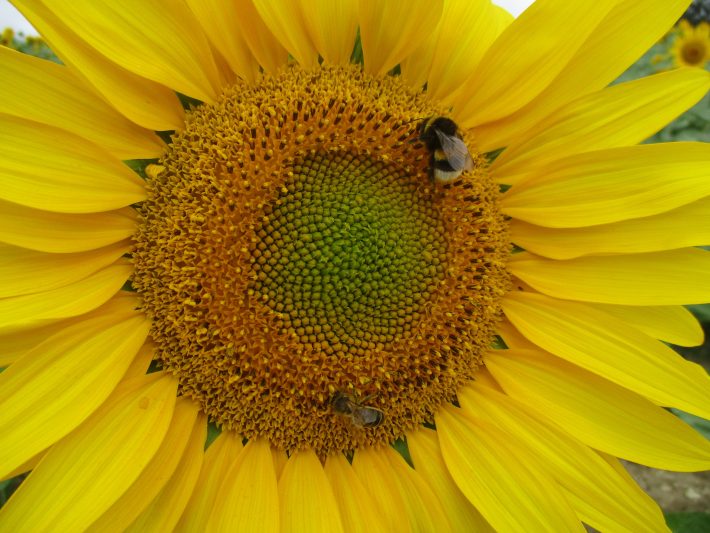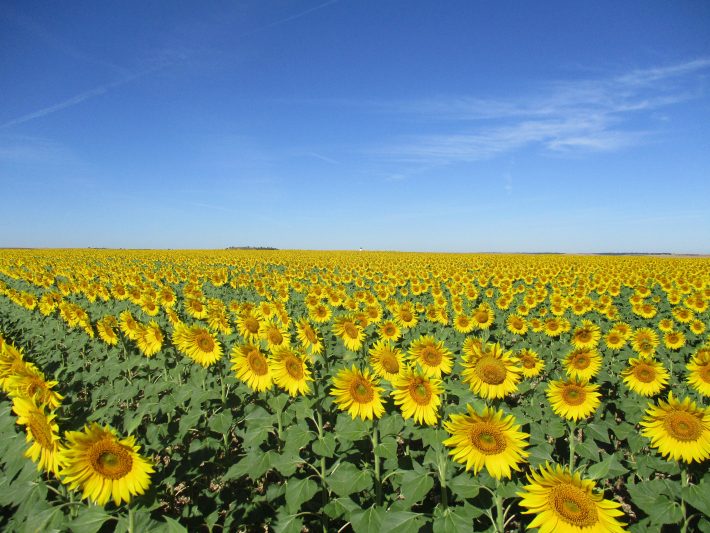Agri-Environmental Strategy Could Boost Crop Productivity and Pollination
University of Coimbra press release.
Maintaining and implementing green infrastructure, such as floral strips and natural vegetation, nearby sunflower agricultural land is essential for pollinator conservation and boosting crop productivity finds new research from scientists at the University of Coimbra published in the Journal of Applied Ecology.

Regions with natural and semi-natural vegetation can benefit from the implementation of wild floral strips as a successful strategy to promote pollinator and sunflower productivity, concludes a new study published in the Journal of Applied Ecology lead by two researchers at the University of Coimbra (UC).
Understanding interactions between pollinators and pollination-dependent crops is crucial for mitigating the effects of agricultural intensification, to satisfy the growing demand for food while considering biodiversity and ecosystem services. This study highlights the importance of green infrastructure for both pollinator conservation and agricultural productivity. Carried out as part of the Poll-Ole-GI SUDOE project, this research was funded by the European Program Interreg-Sudoe and by the European Union’s Research and Innovation Funding Programme Horizon 2020 (Ecostack).
Wild floral strips are small patches found adjacent to crop fields, with floral resources, for example flowering plants, “their main objective is to provide food – pollen and nectar – for pollinator insects, while the agricultural crop is not flowering and when food resources are scarce”, explains Lucie Mota, first author of the scientific article and researcher at the University of Coimbra’s Centre for Functional Ecology.
Green infrastructure provides essential habitats for pollinators, which are crucial for food production
This latest study assesses the benefits of implementing wild floral strips near sunflower fields in two intensive agricultural regions and quantifies their impacts on pollinators and sunflower productivity. Sílvia Castro, co-author of the study and researcher from the Faculty of Sciences and Technology at the University of Coimbra, clarifies that wild floral strips were obtained by “sowing a floral seed mixture of previously selected plants. Pollinator insects feed on the selected flower’s pollen and nectar, which open before sunflowers, moving on to the agricultural crop when it is in bloom”.
The work was carried out in two regions of Spain (Burgos and Cuenca), in sunflower fields with: associated semi-natural vegetation, with wild floral strips, and without vegetation. During the two-year study, the team at the University of Coimbra, in collaboration with partners at the Autonomous University of Madrid and at the University of Burgos, directly observed pollinator visitation rates and measured both seed productivity and weight in 52 fields each year.

The study revealed pollinator visitation rates varied both across and within the years the research took place, likely due to structural differences in the studied landscapes.
In Cuenca, a flower-rich region characterized by patchy landscapes, the benefits of wild floral strips during the studies second year were significantly greater than fields without vegetation. Both higher pollinator visitation rates and field productivity were observed when these green infrastructures were in place.
In contrast, in the Burgos region, no effects were observed among treatments as the pollinator communities were already very depleted, and the implementation of flower strips alone was not sufficient to rescue pollinators levels nor sunflower productivity.
It’s important to preserve some natural green infrastructures close to agricultural fields
The study demonstrates that the benefits from implementing floral strips or maintaining existing semi-natural habitats near sunflower fields is dependent on the landscape itself. In simplified agricultural ecosystems these interventions might not be sufficient or may require more time to produce measurable effects. However, in regions where natural or semi-natural vegetation already exists the implementation of floral strips will likely be a successful strategy to promote both pollinator and sunflower productivity.
According to the researchers, this study appeals to the importance of conserving natural or semi-natural green infrastructures near agricultural landscapes. “Green infrastructure provides essential habitats for pollinators, which are crucial for food production. In this case, the sunflower crop allows the obtention of oils mainly, but this is only possible after an efficient pollination”, says Lucie Mota.
“The conservation of natural habitats allows for the maintenance of pollinator insect communities in agricultural regions and, thus, a higher and better crop yield. In regions with insufficient floral resources, the implementation of wild floral strips seems to be a good agro-environmental strategy, combined with the natural vegetation already present. However, in agricultural regions with few natural vegetation patches, this strategy alone seems to be insufficient; hence the importance of preserving some natural green infrastructures close to the agricultural fields”.
You can read the full research article here:
https://besjournals.onlinelibrary.wiley.com/doi/10.1111/1365-2664.14241
Like what we stand for?
Support our mission and help develop the next generation of ecologists by donating to the British Ecological Society.